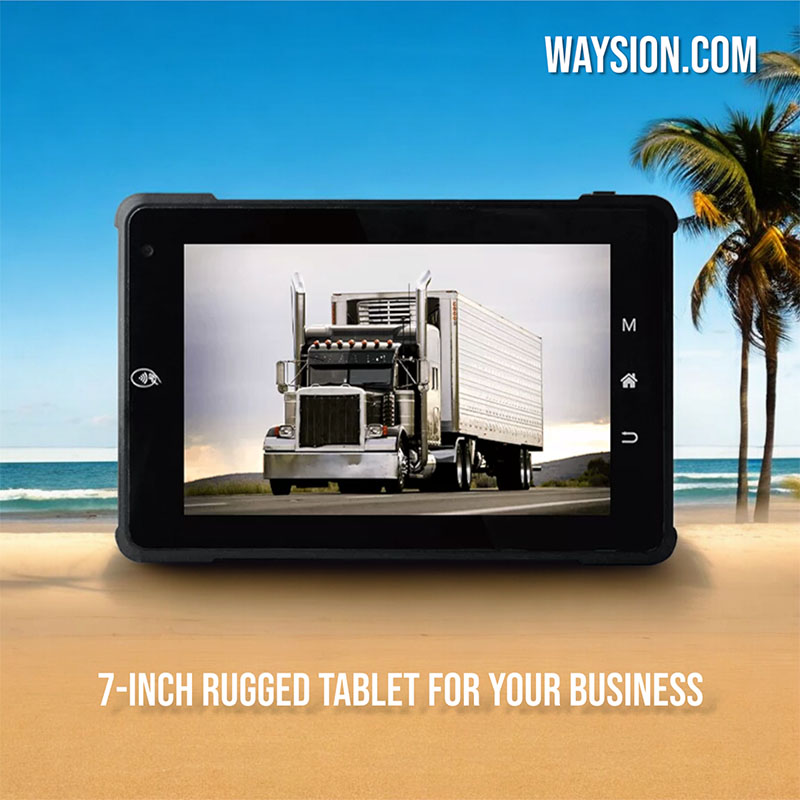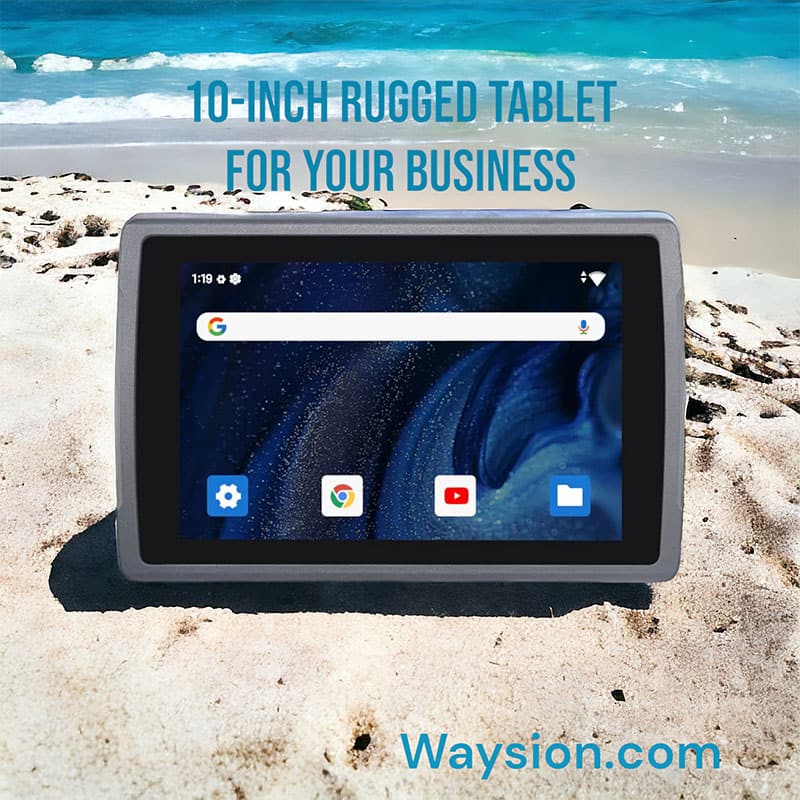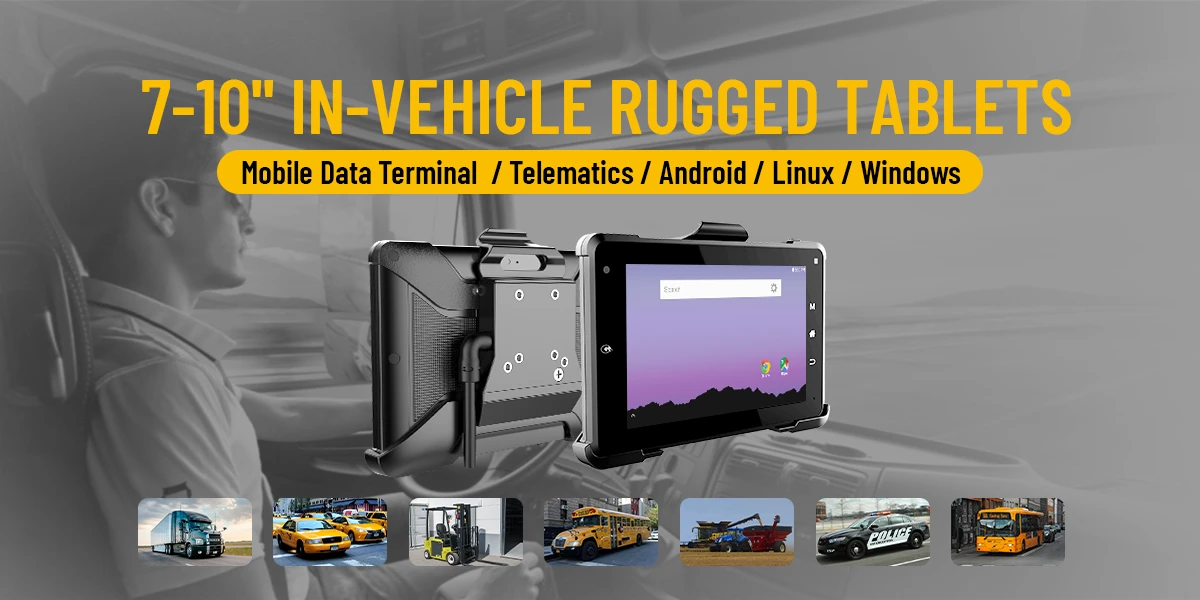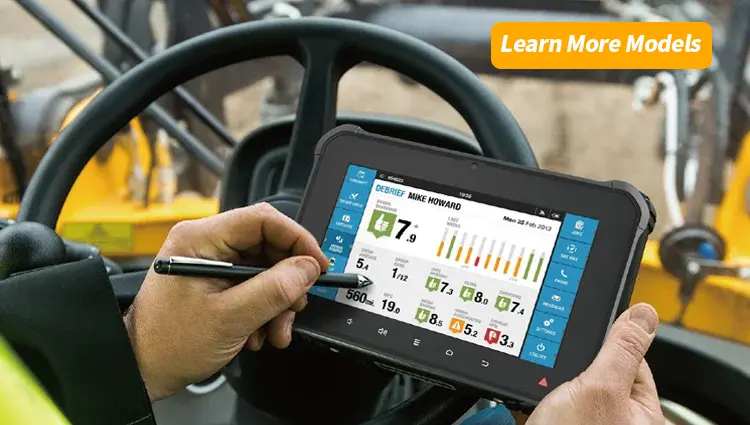How to Choose Between 7-inch and 10-inch Rugged Tablets?
In the world of rugged tablets, both 7-inch and 10-inch models play significant roles. Rugged tablets are designed to withstand harsh environments, including extreme temperatures, dust, water, and physical impacts. The choice between a 7-inch and a 10-inch rugged tablet often depends on various factors such as intended use, portability requirements, and user preferences. This article will conduct a comprehensive comparison between 7-inch and 10-inch rugged tablets in terms of multiple aspects.
Physical Dimensions and Portability
One of the most obvious differences between 7-inch and 10-inch rugged tablets is their size. A 7-inch rugged tablet is much more compact and lightweight. With a smaller footprint, it can easily fit into a pocket, a small bag, or be held comfortably in one hand. This makes it an ideal choice for users who are constantly on the move, such as field workers, delivery personnel, or those who need to operate the device while walking.
On the other hand, a 10-inch rugged tablet is larger and heavier. It may require both hands to hold securely and is not as easy to carry around for extended periods. However, its larger size can also be an advantage in some situations. For example, in a stationary work environment like a factory control room or a laboratory bench, the larger tablet can be placed on a surface for easier viewing and operation.
In terms of portability, if you need to carry the tablet with you all day and use it in various positions, the 7-inch model has a clear edge. But if you mainly use the tablet in a fixed location or don’t mind the extra bulk for a larger display, the 10-inch tablet may be more suitable.

Display
The display is a crucial aspect of any tablet. A 7-inch rugged tablet typically has a smaller screen area. However, with advancements in technology, the screen resolution of 7-inch tablets can still be quite high, providing sharp and clear visuals. The smaller screen also means that the pixel density can be relatively high, resulting in detailed images and text.
A 10-inch rugged tablet offers a much larger display area. This is beneficial for tasks that require a broader view, such as viewing maps, documents with multiple columns, or watching videos. The larger screen allows for more content to be displayed at once, reducing the need for excessive scrolling.
In terms of color accuracy and contrast, both 7-inch and 10-inch rugged tablets have made significant improvements. High – quality models of both sizes can offer vivid colors and good contrast ratios. However, larger displays may sometimes have a slight advantage in terms of overall visual impact due to the increased size.
When it comes to sunlight readability, which is important for outdoor use, both sizes can be equipped with high – brightness screens and anti – glare coatings. Some 10-inch tablets may have a more powerful backlight to make the screen visible in bright sunlight, but this also depends on the specific model and its design.
Performance
In terms of processing power, both 7-inch and 10-inch rugged tablets can be powered by a variety of processors. Modern rugged tablets often come with mid – to high – end processors to ensure smooth performance.
7-inch rugged tablets, due to their smaller size and potentially lower power consumption requirements, may be equipped with processors that are optimized for energy efficiency while still providing sufficient performance for typical tasks such as running apps, browsing the web, and handling basic data processing.
10-inch rugged tablets, on the other hand, may have more room for larger heat sinks and better cooling mechanisms. This allows them to accommodate more powerful processors, which can be beneficial for more demanding tasks such as running complex industrial applications, video editing, or multitasking with multiple heavy – duty apps.
Memory and storage are also important factors. Both sizes can offer a range of memory and storage options. Some 10-inch tablets may have more expandable storage options, either through microSD cards or other expansion ports, which can be useful for storing large amounts of data such as high – resolution images, videos, or extensive databases.
Battery Life
Battery life is a critical consideration for rugged tablets, especially for those used in the field where access to power sources may be limited.
7-inch rugged tablets generally have smaller batteries due to their compact size. However, their lower power consumption (especially with energy – efficient processors) can sometimes result in decent battery life. They may be able to last for several hours of continuous use, depending on the usage pattern, such as light web browsing, occasional app use, and short periods of video playback.
10-inch rugged tablets typically have larger batteries to power their larger displays and potentially more powerful components. This can result in longer battery life in some cases, especially if the device is optimized for power management. However, if the user is running multiple high – power – consuming apps or using the tablet with high – brightness settings for an extended period, the battery may drain more quickly.
In general, it’s important to check the specific battery specifications and user reviews of each model to get a more accurate understanding of their battery performance in real – world scenarios.
Connectivity
Both 7-inch and 10-inch rugged tablets offer a range of connectivity options. They usually come with Wi – Fi capabilities for connecting to local networks, which is essential for accessing the internet, sharing data with other devices, or connecting to enterprise networks.
Bluetooth is also a common feature in both sizes, allowing for the connection of wireless peripherals such as keyboards, mice, and headphones. This can enhance the usability of the tablet in different scenarios.
For cellular connectivity, many rugged tablets of both sizes are available with 4G or even 5G options. This enables users to stay connected to the internet while on the go, which is crucial for applications such as remote monitoring, real – time data transfer, and communication in areas without Wi – Fi access.
In addition, some rugged tablets may offer additional connectivity options such as USB ports (for connecting external storage devices, printers, etc.), HDMI ports (for connecting to external displays), and serial ports (useful in industrial and legacy systems). The availability of these ports may vary between different models of 7-inch and 10-inch tablets, so it’s important to consider your specific connectivity needs when making a choice.

Durability and Ruggedness
As rugged tablets, both 7-inch and 10-inch models are designed to be durable. They are typically built with shock – resistant materials, sealed against dust and water, and can withstand a certain degree of physical abuse.
In terms of water and dust resistance, many rugged tablets are rated according to the Ingress Protection (IP) code. Both sizes can achieve high IP ratings, indicating their ability to function in dusty or wet environments. However, the larger size of the 10-inch tablet may sometimes make it more challenging to achieve the same level of water – tight and dust – tight sealing, although manufacturers have made significant progress in ensuring the durability of larger devices.
When it comes to shock resistance, both 7-inch and 10-inch tablets are tested to withstand drops from a certain height. The smaller and lighter 7-inch tablet may be less likely to suffer severe damage from a drop due to its lower mass, but again, this depends on the specific design and construction of the device.
Some rugged tablets also offer additional features such as sunlight – resistant screens, reinforced corners, and chemical – resistant coatings. These features can further enhance the durability of the tablet in different harsh environments.
User Interface and Input
The user interface (UI) experience can be different between 7-inch and 10-inch rugged tablets. The smaller screen of the 7-inch tablet may require more precise finger gestures for touch – based input. However, the icons and buttons can be designed to be large enough for easy tapping, and some models may offer alternative input methods such as stylus support.
The 10-inch tablet, with its larger screen, provides more space for a more detailed and complex UI. The buttons and menus can be more spread out, making it easier for users to interact with the device using their fingers. Additionally, the larger screen can accommodate split – screen views and multi – window functionality more effectively, allowing for better multitasking.
Both sizes can support external keyboards for more efficient text input. For those who need to type large amounts of text, such as in a field report or a document editing task, connecting an external keyboard can significantly improve productivity.
Cost
The cost is an important factor in the decision – making process. Generally, 7-inch rugged tablets tend to be more affordable than their 10-inch counterparts. This is mainly due to their smaller size, which may require fewer materials and less complex manufacturing processes.
10-inch rugged tablets, with their larger displays, potentially more powerful components, and sometimes more advanced features, often come with a higher price tag. However, the price difference can vary depending on the brand, specifications, and additional features of the tablets.
It’s important to consider the overall value for money when comparing the costs. A more expensive 10-inch tablet may offer better performance, larger storage, and more advanced features that could be worth the investment for certain users, while a more budget – friendly 7-inch tablet may meet the basic needs of other users at a lower cost.
Application Scenarios
7-inch rugged tablets are well – suited for a variety of applications. In the healthcare industry, they can be used by nurses and doctors for quick patient data access at the bedside. Their small size allows for easy handling in a crowded hospital environment. In the logistics and delivery sectors, 7-inch tablets can be used by drivers to manage delivery routes, scan packages, and communicate with the central office.
10-inch rugged tablets are often preferred in industrial control rooms, where the larger display is useful for monitoring complex systems and analyzing detailed data. In the education field, they can be used for interactive learning in classrooms, as the larger screen provides a better viewing experience for educational videos and presentations.
In the field of construction, 10-inch tablets can be used by engineers and supervisors to view construction plans, manage project schedules, and communicate with the construction team. The larger screen allows for a more detailed view of the plans, reducing the chances of errors.

Conclusion
In conclusion, the choice between a 7-inch and a 10-inch rugged tablet depends on a variety of factors. If portability is your top priority and you need a device that can be easily carried and used in different positions, the 7-inch rugged tablet is a great choice. It offers decent performance, good battery life for its size, and is generally more affordable.
On the other hand, if you require a larger display for tasks such as viewing detailed maps, documents, or running complex applications, and you don’t mind the slightly larger size and weight, the 10-inch rugged tablet may be the better option. It can provide more powerful performance, longer battery life in some cases, and a more immersive user experience.








